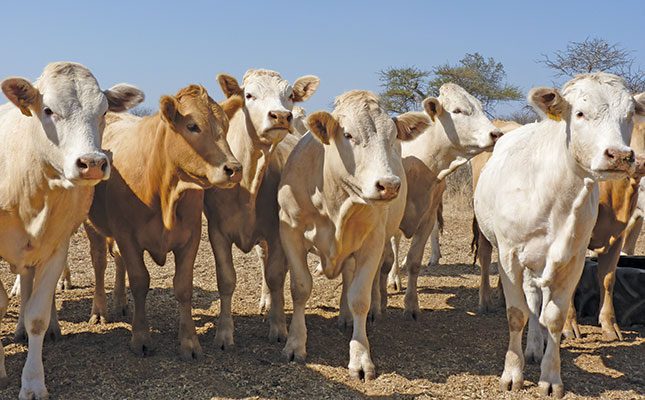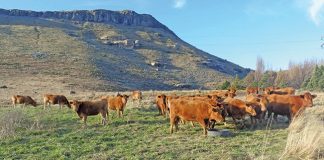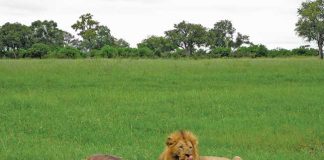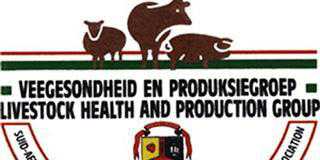
Photo: Supplied
The Hugenoot beef cattle breed was developed by South Africans for South Africa’s taxing extensive farming conditions. It is an economically functional and efficient breed that ensures sustainable and profitable beef production, according to Henk van Rensburg, who runs an award-winning stud with his wife Gerda in the Soutpansberg area of Limpopo.
Their farming concern also includes commercial beef cattle and a feedlot. Maize and potatoes are produced under irrigation for silage, and a pomegranate orchard was recently added. The Van Rensburgs also produce green peppers in hothouses.
Afrikaner and Charolais
“The Hugenoot combines the hardiness of the Afrikaner and the first-rate production efficiency of the Charolais. In 1995, SA Stud Book recognised the Hugenoot and, in 1998, the South Africa Hugenoot Cattle Breeders’ Association was established. We started our Koperkop stud in 2009 on 3 570ha, which includes the farms Altenburg, Leyden, New Hanover and Kalkoven,” Henk explains.
The breed is characterised by outstanding growth and muscling, with exceptionally high dressing percentages. The average dressing percentage for heifer weaners is 58% and for bull weaners 62%. For cows and bulls, the dressing percentage is on average 58% and 73% respectively.
The Hugenoot was developed specifically for weaner production. A combination of 30% Afrikaner genetics and 70% Charolais genetics was used initially, followed later on by a combination of 40% Afrikaner and 60% Charolais.
Gerda says: “The Hugenoot is one of the genetic treasure troves of the Southern African beef production sector. Its progress was meticulously recorded since the development of the breed began, which made it possible for breeders to select the best of the best.
Incidentally, Hugenoot breeders have also recently started with genomic testing as a selection criterion in order to put the finest animals on the market.”
The Koperkop Hugenoots are kept mainly on sweetveld with a strong woody component. The grass component on the Van Rensburg farms consists mainly of white buffalo grass (Panicum maximum), blue Buffalo grass (Cenchrus ciliaris) and bushveld signal grass (Urochloa mosambicensis). Lands used for crop production in the past are planted to dryland sorghum as an additional source of feed for the animals. The average rainfall in the area is 450mm, with temperatures climbing close to 40°C in summer.
“Because there are relatively few Hugenoot stud breeders in South Africa, we’re committed, like the others, to quality,” says Henk. “When we took over the family farm in 1994, we initially continued farming the animals that were on the farm, but we were looking for a breed that was optimally adapted to our farming conditions and challenges, and the Hugenoot met all our expectations.”
The couple initially bought one bull for commercial breeding purposes, followed by registering a few cows as stud animals. In 2009, they took over an entire existing stud concern, and from then onwards the stud went from strength to strength. Three Koperkop cows received platinum awards (in 2019 and 2022) in the Landbouweekblad/SA Studbook National Elite Competition’s beef cow class. Koperkop bulls also frequently qualified for the Vleissentraal/SA Stud Book growth test from 2020 to 2023. The Van Rensburgs have also taken the laurels as the Hugenoot Breeder of the Year six times since 2011.
Fertility and adaptation
The Van Rensburgs’ objective is to breed medium-framed, well-adapted cows. And, according to Henk, they are so committed to the quality and performance of the bulls that they would never market a bull they would not use in their own herds. Bulls need to be fit and vigorous, with a strong libido.
The ideal Koperkop heifer is well muscled, fertile, has high milk production, and has first-rate walking ability. A cow that is unable to raise a calf annually is dropped from the herd. The stud currently consists of 375 cows, 92 heifers and 17 breeding bulls.
The herd is subjected to an extensive range of performance testing, including weight at birth, weaning, 12 months and 18 months. The bulls also undergo Phase D testing in order to estimate muscle growth and to predict carcass composition and beef yield. The information gained in this way is then used to establish breeding values.
Avoiding Myostatin
The entire herd has been DNA-tested for the myostatin gene. Gerda explains: “The myostatin gene influences the production of a protein that controls the development of muscle in cattle, causing what is commonly referred to as ‘double muscling’. Some of the genetic variants can be linked to larger calf birthweights, resulting in increased calving difficulty. Some of these variants are also linked to reduced milk yield, delayed puberty and reduced fertility in females.”
The stud is closed, and the Van Rensburgs use a ratio of one bull for 25 cows. Their relatively high number of bulls means that inbreeding is avoided and the herd’s genetic integrity is not compromised.
Two or three new bulls are introduced each year based on selective breeding principles in order to further avert inbreeding. The average Koperkop birthweight is 38kg, with an average weaning weight of 240kg and an inter-calving period of 393 days. The average first-calf age for cows is 31 months.
The Van Rensburgs’ land is divided into 97 camps of about 38ha each. The planted pastures are also fenced off and used for grazing. During summer months, the herd is kept mainly on these. The animals kept on the veld during summer are rotated weekly to allow ample regrowth for winter. Veld camps not grazed in summer are used for winter grazing.
The official stocking rate in the Dendron/Mara region is 10ha/MLU, but the Van Rensburgs’ planted pastures allow for a somewhat higher stocking rate. Outside the breeding season, the bulls are kept in smaller camps with a feed supplement to prevent damage to the vegetation in the smaller camps.
The Van Rensburgs maintain a summer breeding season. According to them, this simplifies management in terms of the herd’s vaccination programme and weaning, among other reasons.
Breeding and vaccination
The animals are vaccinated against blackleg, anthrax, botulism, lumpy skin disease, rabies, brucellosis. The calves are vaccinated against heartwater. As heartwater and redwater are tick-borne diseases, the entire herd is dipped regularly.
“We’re still building up the herd and have until now not marketed any of our female animals, but will start selling females in the very near future,” say Henk. “Currently, we sell about 30 bulls out of hand and on auction per year. Our target market consists of the stud as well as commercial sectors.
“Because of its hybrid vigour, the Hugenoot is the ideal choice for crossbreeding. Top-quality breeding animals make for top-quality weaners, which will always stand the commercial breeder in good stead. While it takes virtually the same effort and input costs to breed stud and commercial animals, the return on investment for stud animals is markedly higher.”
Quality is paramount
According to Gerda, the biggest mistake they made initially was not to implement the strictest possible selection criteria. This meant that it took them much longer than necessary to reach the goal of breeding optimal-performing animals that would add value to any beef production concern.
“Our best decision, apart from stringent selection, was to invest in silage bunkers. Silage has enabled us to carry the herd through periods of drought. We didn’t have to sell any of our animals and the silage added markedly to the profitability of our feedlot as well,” she says.
Email Henk and Gerda van Rensburg at [email protected], or visit koperkop.co.za.











